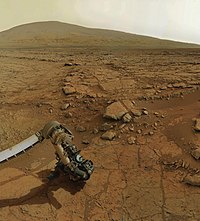
Photo from wikipedia
Abstract Clastic pipes are cylindrical injection features that vertically crosscut bedding with sharp contacts. Terrestrial pipes have cylindrical morphologies, massive or radially graded interiors, and raised outer rims. Increased grain… Click to show full abstract
Abstract Clastic pipes are cylindrical injection features that vertically crosscut bedding with sharp contacts. Terrestrial pipes have cylindrical morphologies, massive or radially graded interiors, and raised outer rims. Increased grain size and subsequent cementation along the more porous edges makes the rims more resistant to weathering. Pipes have crosscutting relationships with other pipes due to multiple formation events or migrating eruption centers, and are associated with other soft-sediment deformation features. Terrestrial clastic pipes form via liquefaction and fluidization, which require a near-surface groundwater system to initiate (i.e., sand-sized sediments must be saturated for pipes to form). Clastic pipes (cm to 1000+ m diameters) occur on Mars across multiple time periods and terrains and are recognized in both rover and orbital imagery. A conical or cylindrical geometry and massive interior/core characterize these features. The pipes on Mars show various geomorphic expressions and are classified into five types by the presence or absence of a raised outer rim, or a central pit. These types are interpreted to represent the erosional evolution of pipes at different stages from their initial surface eruptive structures to their weathered remnants (eroded conical hills). Martian pipes formed via fluidization as evidenced by: 1) raised outer rims possibly indicating textural differences along the pipe edges from traction interactions of fluid-suspended sediment; 2) crosscutting relationships with other pipes suggesting reactivated fluidization pathways or migrating eruptive vents; and 3) close spatial association between pipes and other features thought to form by soft-sediment deformation (e.g., contorted bedding). Integration of terrestrial analog data with the Mars observations provides evidence for past Martian groundwater and subsurface fluid mobilization.
Journal Title: Icarus
Year Published: 2019
Link to full text (if available)
Share on Social Media: Sign Up to like & get
recommendations!